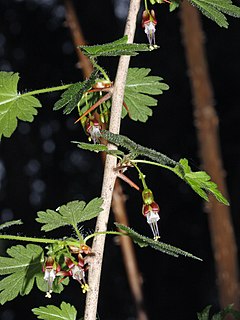
The glaucophytes, also known as glaucocystophytes or glaucocystids, are a small group of freshwater unicellular algae, less common today than they were during the Proterozoic. Only 15 species have been described, but more species are likely to exist. Together with the red algae (Rhodophyta) and the green algae plus land plants, they form the Archaeplastida. However, the relationships among the red algae, green algae and glaucophytes are unclear, in large part due to limited study of the glaucophytes.

Bulbophyllum is a genus of mostly epiphytic and lithophytic orchids in the family Orchidaceae. It is the largest genus in the orchid family and one of the largest genera of flowering plants with more than 2,000 species, exceeded in number only by Astragalus. These orchids are found in diverse habitats throughout most of the warmer parts of the world including Africa, southern Asia, Latin America, the West Indies, and various islands in the Indian and Pacific Oceans. Orchids in this genus have thread-like or fibrous roots that creep over the surface of trees or rocks or hang from branches. The stem is divided into a rhizome and a pseudobulb, a feature that distinguished this genus from Dendrobium. There is usually only a single leaf at the top of the pseudobulb and from one to many flowers are arranged along an unbranched flowering stem that arises from the base of the pseudobulb. Several attempts have been made to separate Bulbophyllum into smaller genera, but most have not been accepted by the World Checklist of Selected Plant Families.

In botany, a caryopsis is a type of simple dry fruit—one that is monocarpellate and indehiscent and resembles an achene, except that in a caryopsis the pericarp is fused with the thin seed coat.

Ribes is a genus of about 200 known species of flowering plants native throughout the temperate regions of the Northern Hemisphere. The various species are known as currants or gooseberries, and some are cultivated for their edible fruit or as ornamental plants. Ribes is the only genus in the family Grossulariaceae.

François Gagnepain was a French botanist. The standard botanical author abbreviation Gagnep. is applied to plants described by Gagnepain.

Phyllanthus is the largest genus in the flowering plant family Phyllanthaceae. Estimates of the number of species in this genus vary widely, from 750 to 1200. Phyllanthus has a remarkable diversity of growth forms including annual and perennial herbs, shrubs, climbers, floating aquatics, and pachycaulous succulents. Some have flattened leaflike stems called cladodes. It has a wide variety of floral morphologies and chromosome numbers and has one of the widest range of pollen types of any seed plant genus.
Spondianthus is a genus of plant, in the family Phyllanthaceae and is the only genus comprised in the tribe Spondiantheae. It was first described as a genus in 1905. The genus contains only one recognized species, Spondianthus preussii, widespread across much of tropical Africa from Liberia to Mozambique.
- Spondianthus preussii subsp. glaber(Engl.) J.Léonard & Nkounkou – from Nigeria to Tanzania south to Angola; also Guinea, Ivory Coast
- Spondianthus preussii subsp. preussii – from Liberia to Zaire
Protomegabaria is a genus of flowering plant belonging to the family Phyllanthaceae first described as a genus in 1911. It is native to western and central Africa. It is dioecious, with male and female flowers on separate plants.
- Protomegabaria macrophylla(Pax) Hutch. - Nigeria, Cameroon, Republic of the Congo, Gabon, Gulf of Guinea Islands
- Protomegabaria meiocarpaJ.Léonard - Gabon, Democratic Republic of the Congo
- Protomegabaria stapfiana(Beille) Hutch. - West Africa

Uapaca is a genus of plant, in the family Phyllanthaceae first described as a genus in 1858. It is the only genus comprised in the tribe Uapaceae. The genus is native to Africa and Madagascar. Uapaca is dioecious, with male and female flowers on separate plants.

Breynia is a plant genus in the family Phyllanthaceae, first described in 1776. It is native to Southeast Asia, China, the Indian Subcontinent, Papuasia, Australia, and the island of Réunion.

Lachnostylis is a genus of the family Phyllanthaceae first described as a genus in 1846. It comprises native to the Eastern Cape and the Western Cape Provinces of South Africa. It is often included in Savia. It is dioecious, with male and female flowers on separate plants.
- Lachnostylis bilocularisR.A.Dyer
- Lachnostylis hirta(L.f.) Müll.Arg.

Plateau de Beille is a ski resort in the Pyrenees. It is situated in the Ariège department, and in the region of the Occitanie. The winter sports resort lies at a height of 1,790 m (5,870 ft).

Oxygyne is a genus of plant in family Burmanniaceae, first described as a genus in 1906. It has a highly disjunct distribution, found in Japan in East Asia and in Cameroon in Central Africa.

Beillé is a commune in the Sarthe department in the region of Pays de la Loire in north-western France.

Naucleeae is a tribe of flowering plants in the family Rubiaceae and contains about 183 species in 24 genera. Species belonging to Naucleeae occur from Australasia, tropical Asia, Madagascar, tropical Africa, and to the Neotropics and North America.
Olpidiaceae is a fungal plant pathogen families that was placed in the order Chytridiales.

Octotropideae is a tribe of flowering plants in the family Rubiaceae and contains about 103 species in 18 genera. Its representatives are found in the paleotropics.
Dewevrella is a genus of plants first described in 1907. It contains only one known species, Dewevrella cochliostema, native to central Africa.

Sciapodinae is a subfamily of flies in the family Dolichopodidae.
Lemyrea is a genus of flowering plants belonging to the family Rubiaceae.














